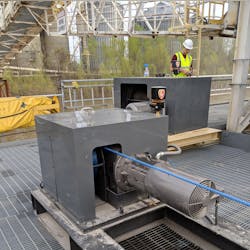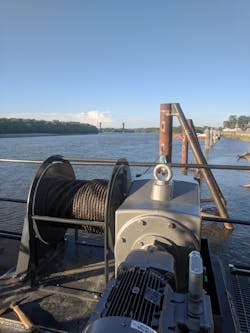Superior Performance
Oil and gas, grain and timber, iron ore and coal. These are just a few of the raw materials that keep the wheels of civilization turning each day. How they get delivered to the mills and refineries that convert them into usable products, however, is something to which few among us give much thought. Kent Phillips does. The president and CEO of the Superior Lidgerwood Mundy Corporation (SLM Corp.), he and his team spend their days manufacturing a host of advanced equipment that makes barge traffic and so much more possible.
One of the primary contributors to these efforts? NORD DRIVESYSTEMS, a global leader in mechanical and electronic drive technology. "The marriage of flexible design practices, applied engineering, and passionate commitment to helping the industry as a whole—that's what separates us from our competition," says Phillips. "NORD plays an important role in this corporate vision."
What's Old Is New Again
Chat for a few minutes with Phillips or his brother Sean Tenerelli, responsible for commercial business development at SLM, and you'll be left with the impression that this is a very young company, one filled with modern ideas and bold plans. In reality, the Superior, Wisconsin-based provider of winches, hoists, capstans, and barge positioning systems will soon celebrate its 150th birthday.
SLM got its start in the lumber industry, Tenerelli explains. Its products were not only used to move lumber onto railcars in remote locations but also to pull stranded or derailed trains back onto the track. The company has roots in cableway systems as well, where its hoisting innovations led to recognition in multiple World's Fairs and were incredibly important to the construction of historical landmarks such as the Panama Canal and Hoover Dam. Some of these systems are still in operation today.
Finally, SLM has been involved in the design and implementation of winch, capstan, and hoist solutions for the US government since the dawn of the war department, a partnership that continues to this day. "Look at any of the military vessels built over the last 150 years and the chances are excellent that you'll see our equipment," says Tenerelli.
Despite this proud history—or perhaps because of it—SLM has begun to transform itself over recent years. After the retirement of several key employees, the company began looking for ways to combine their unique experience in mechanical lifting devices with modern drive technology. This includes state-of-the-art control systems, hydraulically-actuated leveling equipment, and automated solutions that make SLM products more cost-effective, reliable, and above all, safer.
Drive to Success
"That's where our relationship with NORD started," says SLM's engineering and external affairs manager Kenneth Behrman. "In order to accomplish our goals, we had to find the very best drive technology available and the application support necessary to integrate it with our winches and hoists. We soon found that NORD has both, with a broad product selection and excellent availability, as well as the price points we needed to be competitive."
One of the first examples of this collaboration was on a funicular hoist used to transport personnel to and from a hydroelectric dam located in the southeastern United States. SLM built the original system in 1912, and while it was still functional, the customer was asking that it be upgraded to modern operational standards. One of the challenges, however, was that the facility is protected by historic preservation laws, so the replacement equipment had to be minimally invasive.
"To design a hoist that would fit into the original space but meet today's much higher safety factors, SLM worked with NORD to design a CLINCHER gearbox paired with an open gearing set," says Behrman. "CLINCHERs are typically used for agitators and mixers or conveyors, but the unit they recommended possessed the required characteristics for in-line operation with an open gearing set as well as the capacity to transmit the required power generation, all in a small footprint."
Avoiding the River Walk
In another example, SLM addressed the need for more efficient and standardized barge positioning systems. Behrman notes that legacy positioners are often unique to each loading facility, based on decades-old technology that requires a high level of experience to operate. Given the current labor shortage and the fact that many dock workers are approaching retirement age, these skills are increasingly hard to find.
What's more, much of this work is manual—personnel must hoist heavy lines and walk along the sides of barges and docks, even in inclement weather. "It's a difficult and unsafe job," he says. "Because of this, it's tough to find people today that are willing to do it, and those who are willing are usually only familiar with whatever system they were trained on. We wanted to develop a standardized, largely automated system that someone can operate with minimal operator training."
Tenerelli agrees, noting that one of the main challenges to these systems is to balance operational needs with a cost-effective solution. "We found early on that facility owners were asking for better safety and efficiency, but usually balked at the price tag," he says. "This led us to develop our S-Series of standard winches, which is NORD-based and offers a great ratio of cost, efficiency, and the desired safety improvements."
Engineering manager Behrman adds to this, stating "In this and countless other examples, NORD's engineering team has provided sizing and application advice that keeps us on the forefront of design improvements. We are now able to apply gear motors in unique applications with the full support of the manufacturer's engineering team, allowing us to offer solutions that most cannot."
Don't Trip
Similarly, the operation of the tripper conveyors used at the tops of these grain, coal, and fertilizer facilities is not for the faint of heart. Here, a worker must manually engage a hydraulic clutch to activate a tripper device, dumping whatever material the belt is carrying into the elevator or railcar waiting below. When the tripper stops, the only thing holding it in place is a series of brakes that are notoriously unreliable given the extreme loads and extended service of such equipment.
Adding even more risk to this scenario is the fact that operators are often required to work hundreds of feet in the air, where any slip or equipment malfunction might send them toppling to a rapidly moving belt or the ground below. On top of this is the constant exposure to grain dust, which is not only hazardous to the workers' lungs but explosive as well.
Says Behrman, "For us here at SLM, this sort of working environment is intolerable. But by using a pair of right angle, vertically-mounted winches equipped with NORD gearboxes and an advanced positioning control system, we've developed a system that gives operators full control from a remote station. This eliminates the need for personnel to work on or near the tripper, and provides much greater accuracy, avoiding the spillage that so often occurs with old-fashioned equipment."
Moving Forward
There are many more examples, most of which utilize drive technology from NORD. In fact, Behrman and the SLM engineering team have created a ten-step development philosophy that they apply to all projects and which usually calls for NORD gearboxes. This methodology employs a "standardized products applied to customized solutions" approach in lieu of having to develop solutions from scratch every time."
Safety and process improvements are fundamental to our success," he says. "Whenever possible, we use completely enclosed gearing in our solutions. This decreases the possibility of human injury, drastically cuts maintenance and inspection time, and significantly extends equipment life. Because NORD products allow us to accomplish most of our solutions without open gears, chains, or belts, we're able to provide offerings that are safer and have higher ROI than our competitors."
SLM president Kent Phillips summarizes the relationship with NORD as follows. "Around ten years ago, we made the decision to take all that we'd learned during our years working with the military and various government agencies and bring it to the commercial market. We wanted to have customizable solutions that are built off a standardized platform, giving us the flexibility to arrange everything the way we wanted and deal with different levels of geometry and environmental constraints, but without the need for a fully customized package."
That's where NORD came in, he concludes. "They really helped us. They became a committed partner, paying attention to our needs and showing a high level of interest in our success. The relationship has been very good for us."


